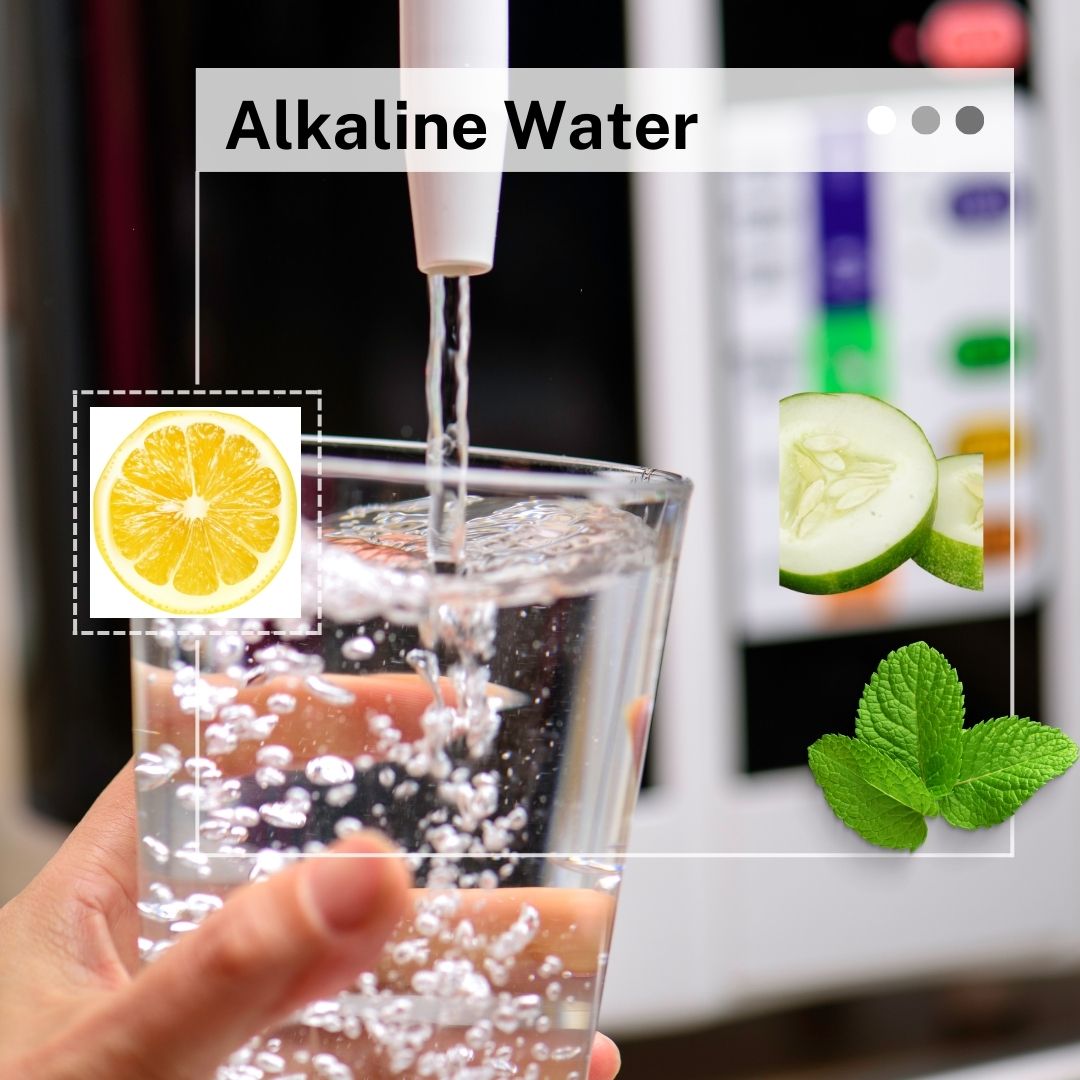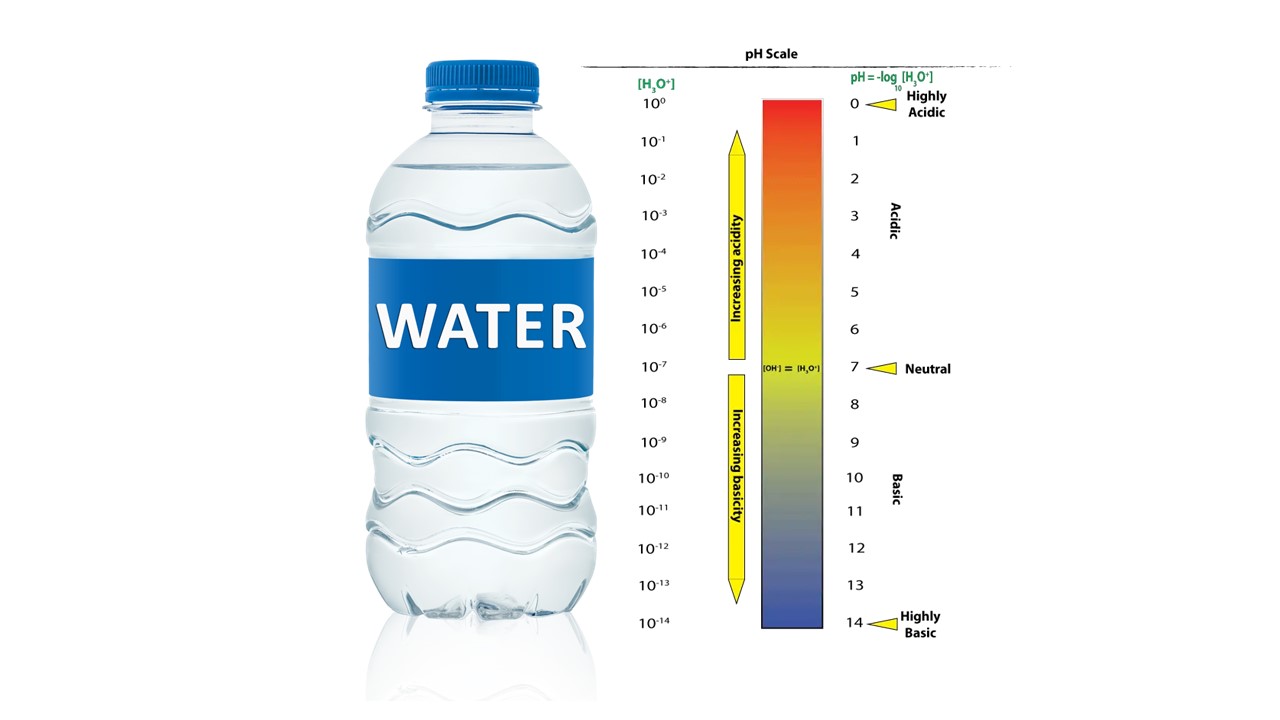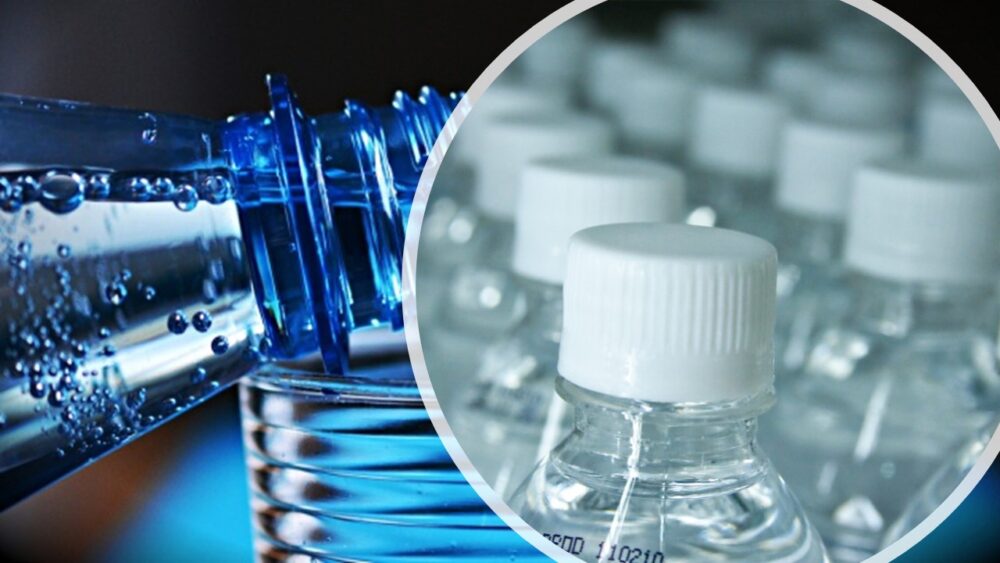How To Make Water Alkaline At Home In 10 Easy Ways
Wondering how to make water alkaline at home? It’s simpler than you might think. One of the easiest ways is to add baking soda to your water. Simply stir 1/8 tbsp of baking soda into 1 cup (240 mL) of water, and you’re good to go! But there is more to learn in this article!
Alkaline water, often praised for its potential health benefits, is believed to help counterbalance the acidic load in our bodies to improve hydration. Research suggests that maintaining a slightly alkaline pH level in your body may support overall well-being as alkaline water is less acidic.
In this article, we’ll show you how to make alkaline water at home using different methods. We’ll also go over the potential benefits and risks of drinking it, as well as the science behind it. We’ll also discuss the importance of testing pH levels and safety precautions. So, read on to know more.
RELATED: What Is The Difference Between Drinking Water And Purified Water
How To Make Water Alkaline At Home
Creating alkaline water at home can be done using simple and affordable ingredients. Here are 10 methods along with accurate measurements and instructions for each:
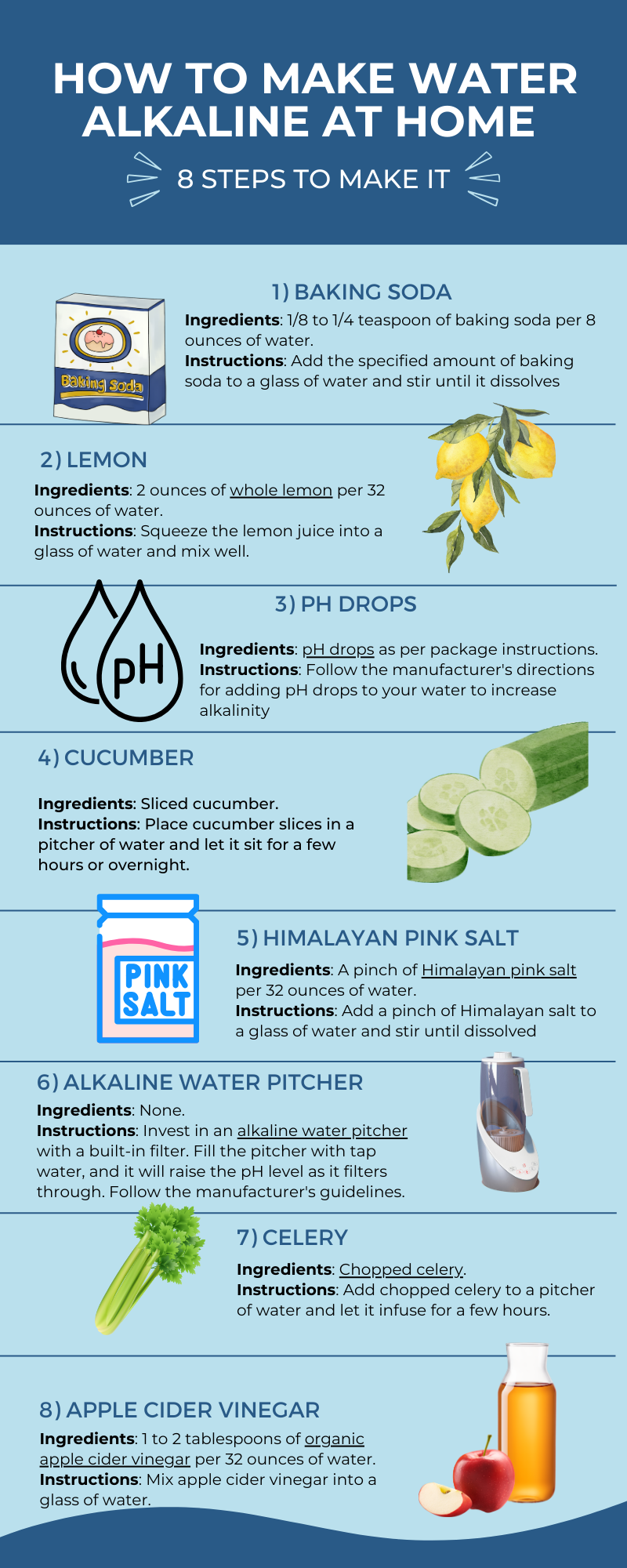
1. Baking Soda Method
– Ingredients: 1/8 to 1/4 teaspoon of baking soda per 8 ounces of water.
– Instructions: Add the specified amount of baking soda to a glass of water and stir until it dissolves. This raises the water’s pH level, reducing the water acidity.
Do not drink more than a glass of baking soda each day as drinking too much of it can cause muscle weakness, diarrhea and vomiting.
2. Lemon Method

– Ingredients: 2 ounces of whole lemon per 32 ounces of water.
– Instructions: Squeeze the lemon juice into a glass of water and mix well. Lemons have natural alkalizing properties despite being acidic in nature.
3. pH Drops Method
– Ingredients: pH drops as per package instructions.
– Instructions: Follow the manufacturer’s directions for adding pH drops to your water to increase alkalinity. This is a precise method for adjusting pH levels.
4. Cucumber Method

– Ingredients: Sliced cucumber.
– Instructions: Place cucumber slices in a pitcher of water and let it sit for a few hours or overnight. Cucumbers can impart a mild alkaline effect to the water.
5. Alkaline Water Pitcher Method
– Ingredients: None.
– Instructions: Invest in an alkaline water pitcher with a built-in filter. Fill the pitcher with tap water, and it will raise the pH level as it filters through. Follow the manufacturer’s guidelines.
6. Himalayan Salt Method
– Ingredients: A pinch of Himalayan pink salt per 32 ounces of water.
– Instructions: Add a pinch of Himalayan salt to a glass of water and stir until dissolved. This can contribute to alkalinity and provide essential minerals.
7. Celery Method
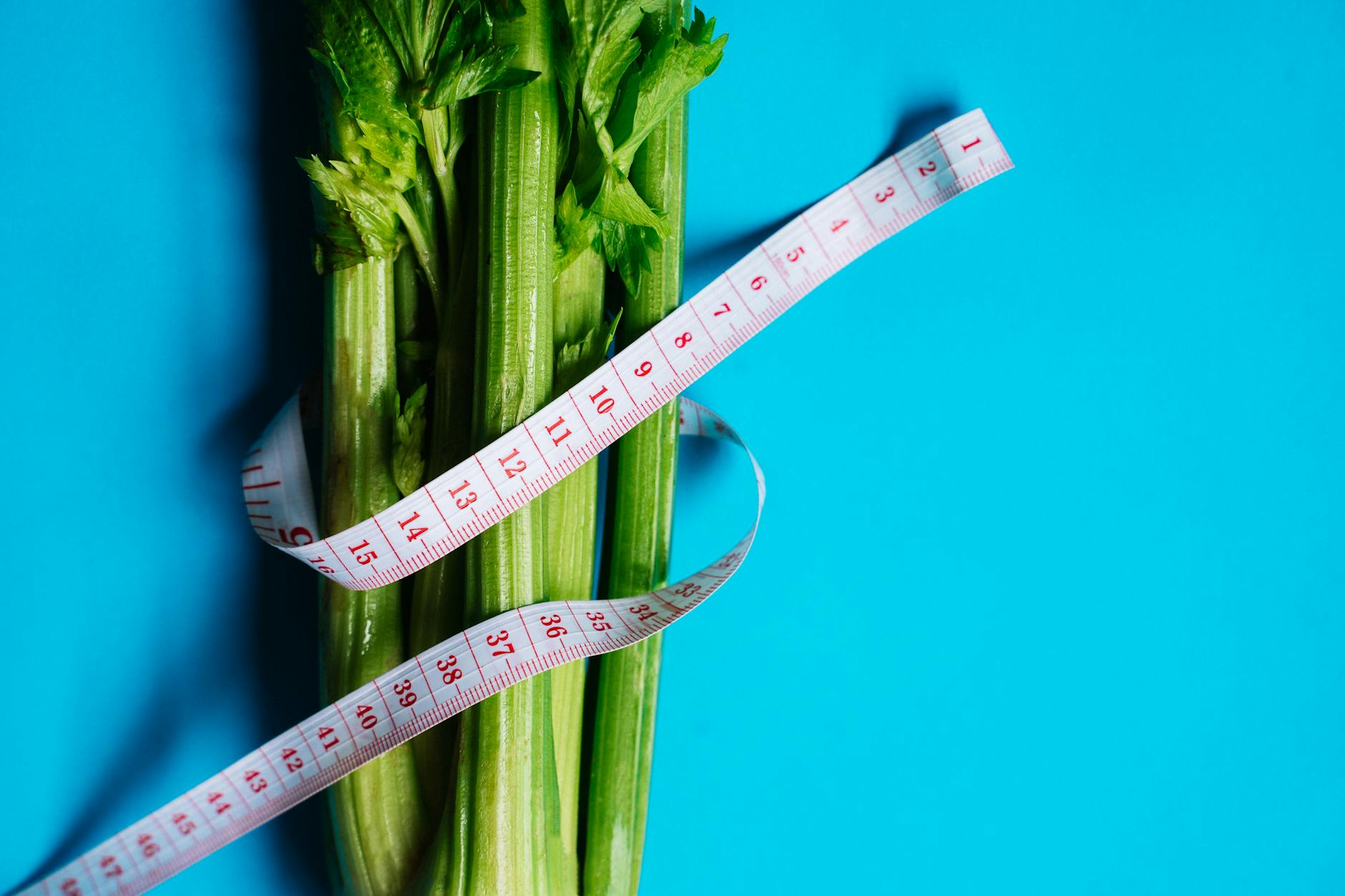
– Ingredients: Chopped celery.
– Instructions: Add chopped celery to a pitcher of water and let it infuse for a few hours. Celery is rich in minerals that can increase alkalinity.
8. Apple Cider Vinegar Method
– Ingredients: 1 to 2 tablespoons of organic apple cider vinegar per 32 ounces of water.
– Instructions: Mix apple cider vinegar into a glass of water. Despite being acidic, it has an alkalizing effect on the body when metabolized.
9. Green Powder Method
– Ingredients: 1 teaspoon of alkalizing green powder (such as spirulina or wheatgrass) per 8 ounces of water.
– Instructions: Add the green powder to a glass of water and stir well. Green powders are naturally alkaline and rich in minerals.
10. Mineral Drops Method
– Ingredients: Alkaline mineral drops as per package instructions.
– Instructions: Follow the manufacturer’s guidelines for adding alkaline mineral drops to your water. These drops typically contain a blend of essential minerals.
Always start with the recommended measurements and adjust according to your taste preferences. Remember that achieving the desired pH level may require some experimentation.
It’s also important to consult with a healthcare professional before making significant changes to your water consumption, especially if you have underlying health conditions.
What Is Alkaline Water? (How To Make Water Alkaline At Home)
Alkaline water is water that has a higher pH level than regular tap water. The pH scale measures the acidity or alkalinity of a substance, with values ranging from 0 to 14. A pH of 7 is considered neutral, while values below 7 are acidic, and values above 7 are alkaline or basic.
Typically, regular tap water has a pH level around 7, which is considered neutral. Alkaline water, on the other hand, has a pH level that is higher, usually between 8 and 9, although it can vary. Some specialized alkaline water products claim to have even higher pH levels.
The concept behind alkaline water is that it can help neutralize excess acid in the body. Some proponents of alkaline water believe that consuming it can provide various health benefits, such as better hydration, improved digestion, and the ability to counteract the effects of acidic foods and beverages in the diet.
It is also believed to act as an antioxidant, although scientific evidence supporting these claims is limited and often inconclusive.
It’s important to note that while alkaline water may have certain perceived benefits for some individuals, the scientific community has not reached a consensus on its overall health effects.
As with any dietary or lifestyle change, it’s a good idea to consult with a healthcare professional before making significant alterations to your water consumption or diet.
Benefits Of Alkaline Water (How To Make Water Alkaline At Home)
Alkaline water offers several potential benefits, although it’s important to note that scientific research supporting these claims is often limited and sometimes inconclusive. Here are some of the benefits of alkaline water as suggested by its advocates:
- Improved Hydration: Alkaline water is believed by some to be more effective at hydrating the body due to its higher pH level. It is thought to have smaller water clusters that can be absorbed more readily by cells. However, scientific evidence supporting this claim is limited.
- Antioxidant Properties: Alkaline water is often touted for its potential antioxidant effects. It is believed to help combat free radicals in the body, which can contribute to aging and various health issues. Antioxidants are generally considered beneficial for health.
- Neutralizing Acidic Conditions: Some people believe that consuming alkaline water can help neutralize excess acidity in the body. Proponents suggest that modern diets high in acidic foods and beverages can lead to health problems, and alkaline water is seen as a way to counterbalance this acidity.
- Improved Digestion: Alkaline water advocates claim that it can aid in digestion by reducing stomach acidity and preventing acid reflux. However, scientific evidence on this topic is inconclusive.
- Bone Health: Some individuals believe that alkaline water can support bone health by providing essential minerals like calcium and magnesium. However, this is a topic of debate, as the body’s ability to absorb minerals from water is limited.
- Increased energy levels. Alkaline water can help to improve energy levels and reduce fatigue.
- Improved skin health. Alkaline water can help to improve skin health by reducing inflammation and acne.
- Overall Well-Being: Alkaline water is often associated with claims of increased energy, improved mood, and better overall health. These perceived benefits may vary from person to person.
Is Alkaline Water Good For You? (How To Make Water Alkaline At Home)
There is some evidence to suggest that alkaline water may have certain health benefits, such as improved hydration and antioxidant levels, but more research is needed to confirm these findings. However, there are a few research that indicate that alkaline water is good for you.
Here are a few research that suggest alkaline water is good for you:
- A 2021 study on women with osteoporosis suggests alkaline water may help improve bone density.
- A study conducted on mice in 2020 found that daily intake of alkaline water improved the mice’s marker of aging.
- Another study carried out on mice in 2018 suggested that drinking alkaline water may help reduce nonalcoholic fatty liver disease symptoms.
Alkaline Water Vs. Regular Water (How To Make Water Alkaline At Home)
| Aspect | Alkaline Water | Regular Water |
| pH Level | Higher pH (typically 8-9) | Neutral pH (around 7) |
| Taste | May have a slightly bitter taste | Typically tasteless or neutral |
| Source | Can be created by adding alkalizing agents or purchased as specialized products | Comes from various sources such as tap, well, or bottled water |
| Hydration | Some claim it provides better hydration due to its higher pH, but scientific evidence is limited | Generally effective at hydrating the body |
| Potential Benefits | Believed to have antioxidant properties. It may help neutralize excess acidity in the body. It can also support overall well-being | Provides essential hydration but lacks the perceived health benefits of alkaline water |
| Cost | Can be more expensive, especially for specialized alkaline water products | Typically more affordable and widely accessible |
| Scientific Support | Limited scientific evidence for many claimed benefits | Well-established as a reliable source of hydration with no specific health claims |
| Suitability for All | Not suitable for everyone, especially those with certain medical conditions | Suitable for most individuals unless there are specific water quality issues |
| Regulation | May not be regulated as rigorously as tap water | Subject to stringent safety and quality regulations in many countries |
| Environmental Impact | The production of specialized alkaline water products can have an environmental footprint | Generally has a lower environmental impact, especially if consumed from the tap or reusable bottles |
Does Alkaline Water Have Side Effects? (How To Make Water Alkaline At Home)
While alkaline water is generally considered safe for most people when consumed in moderation, there are some potential side effects and considerations to be aware of:
1. Gastrointestinal Issues
Drinking highly alkaline water with a pH level significantly above 9 may lead to gastrointestinal discomfort in some individuals. This can include symptoms such as nausea, vomiting, and stomach cramps. It’s essential to avoid excessively high pH levels.
2. Calcium and Mineral Imbalance
Alkaline water can contain higher levels of dissolved minerals, including calcium and magnesium. While these minerals are generally beneficial, excessive intake could lead to mineral imbalances in the body, potentially affecting bone health.
3. Interference with Medication
Alkaline water’s mineral content can interfere with the absorption of certain medications. If you are taking medications, consult with your healthcare provider to ensure that alkaline water does not affect their efficacy.
4. Hydration
While proponents claim that alkaline water hydrates the body more effectively, scientific evidence supporting this claim is limited. Depending on the source and preparation, it may not offer any significant advantage over regular water in terms of hydration.
5. Expense
Specialized alkaline water products or machines can be more expensive than regular water, which may not be practical for everyone.
6. Lack of Scientific Consensus
Many of the health claims associated with alkaline water, such as its ability to neutralize acidity or provide unique health benefits, lack strong scientific consensus. The research on these topics is ongoing, and more evidence is needed to make definitive conclusions.
7. Not Suitable for Everyone
Individuals with certain medical conditions, such as kidney disease or those on restricted diets, may need to limit their consumption of alkaline water or avoid it altogether. Consult with a healthcare professional if you have concerns.
How To Test The pH Levels Of Water Before And After Making It Alkaline (How To Make Water Alkaline At Home)
Testing the pH levels of water before and after making it alkaline is a straightforward process. You can use pH test strips or a pH meter to measure the pH of the water. Here’s how to do it:
Materials You’ll Need
- pH test strips or a pH meter
- The water you want to test.
- A clean, dry container or glass
Testing pH Levels Before Alkalization
- Start by collecting a sample of the water you want to test in a clean container or glass.
- If you’re using pH test strips:
- Dip a pH test strip into the water for a few seconds, making sure the entire strip is submerged.
- Remove the strip and wait for the specified amount of time mentioned on the strip’s packaging (usually a few seconds to a minute).
- Compare the color of the strip to the color chart provided with the strips. This will give you the pH reading of the water. Note down the pH level.
If you’re using a pH meter:
- Turn on the pH meter and allow it to calibrate if necessary, following the manufacturer’s instructions.
- Immerse the pH meter’s electrode into the water sample, making sure it’s fully submerged.
- Wait for a few moments until the pH meter stabilizes and provides a reading. Note down the pH level.
Making the Water Alkaline
To make the water more alkaline, you can use one of the methods mentioned earlier in this article, such as adding baking soda, lemon, or alkaline drops. Follow the specific instructions for the method you choose.
Testing pH Levels After Alkalization
Once you’ve alkalized the water as desired, repeat the pH testing process:
- Collect a fresh sample of the alkalized water in a clean container or glass.
- Use the same pH test strips or pH meter as before to measure the pH level of the alkalized water.
- Note down the pH reading.
Interpreting the Results
- If the pH level of the water increased after alkalization and is now in the alkaline range (typically above 7), you have successfully made alkaline water.
- If the pH level did not increase significantly or remained in the neutral range, you may need to adjust the alkalizing method or ingredient used.
By testing the pH levels before and after making water alkaline, you can gauge the effectiveness of your chosen method and ensure that you have achieved the desired pH level.
Remember that the ideal pH level for alkaline water is often considered to be between 8 and 9, but this can vary depending on personal preferences.
DIY vs. Commercial Products (How To Make Water Alkaline At Home)
| Aspect | DIY Alkaline Water | Commercial Alkaline Water Products |
| Cost | Usually cost-effective | Can be more expensive upfront |
| Control Over Alkalinity | Limited control, varying pH levels depending on method | Precise control over pH levels, often adjustable |
| Convenience | Requires preparation each time | Ready-to-use and convenient for daily consumption |
| Customization | Limited ability to customize to specific pH preferences | Many products allow you to choose the desired pH level |
| Taste | May alter the taste of water depending on the method | Typically designed to have a neutral or enhanced taste |
| Consistency | pH levels may vary between batches | Maintains consistent pH levels |
| Variety | Limited to DIY methods and ingredients | A wide variety of products, including bottled alkaline water, water ionizers, and alkaline water filters |
| Environmental Impact | Generally has a lower environmental impact, especially if using natural ingredients | Bottled alkaline water can generate plastic waste; water ionizers may consume electricity |
| Mobility and Portability | DIY methods can be implemented anywhere | Some commercial products, like water ionizers, are stationary |
| Maintenance | Low maintenance for DIY methods | Commercial products may require maintenance (e.g., filter replacement) |
| Monitoring pH | Requires pH test strips or meter for monitoring | pH levels are typically measured and displayed by commercial products |
| Ease of Use | Requires basic knowledge and preparation | Generally user-friendly with clear instructions |
| Availability | Ingredients for DIY methods are widely available | Availability of commercial products may vary by region |
| Health Benefits Claims | Limited scientific support for health claims | Often marketed with health claims (e.g., improved hydration, antioxidant properties) |
How To Make Alkaline Water For Weight Loss (How To Make Water Alkaline At Home)
Alkaline water is sometimes associated with weight loss due to its perceived health benefits, such as improved hydration and potential assistance with digestion.
However, it’s important to note that the impact of alkaline water on weight loss is not well-established, and any weight loss achieved is likely to be minimal. If you’re interested in incorporating alkaline water into your weight loss journey, here’s how to make it:
Ingredients
- 1 liter (approximately 32 ounces) of clean, filtered water.
- A source of alkalinity (choose one):
- Baking soda: 1/8 to 1/4 teaspoon.
- Lemon juice: Juice from half a lemon or more, to taste.
- Alkaline water drops or pH drops: Follow the manufacturer’s instructions.
- Alkaline water filter: If you have a water ionizer or an alkaline water filter, follow the manufacturer’s guidelines.
Instructions
- Choose Your Alkalinity Source:
- Baking Soda Method: Add 1/8 to 1/4 teaspoon of baking soda to a liter of water. Stir until the baking soda dissolves. Start with the lower amount and adjust to your taste preference.
- Lemon Method: Squeeze the juice from half a lemon into a liter of water. Mix well. Lemon, although acidic in nature, is believed to have alkalizing effects in the body.
- Alkaline Water Drops or Filters: Follow the manufacturer’s instructions to achieve the desired pH level.
- Stir or Shake: Ensure that the alkalinity source is thoroughly mixed with the water.
- Consume: Drink this alkaline water throughout the day as a part of your daily hydration routine. You can have it at room temperature or refrigerated, depending on your preference.
Important Considerations
- Moderation is key. Do not consume excessive amounts of alkaline water, as it may lead to potential side effects.
- Alkaline water should complement a healthy diet and lifestyle for any potential weight loss benefits to be realized.
- Weight loss primarily relies on factors such as calorie intake, physical activity, and overall diet quality. Alkaline water, if it has any impact, is likely to be a minor contributor.
- Consult with a healthcare professional or nutritionist before making significant dietary changes or relying solely on alkaline water for weight loss.
Remember that while alkaline water may have some perceived health benefits, including improved hydration and digestion, it should be considered as a part of an overall balanced and healthy lifestyle rather than a sole strategy for weight loss.
How To Make Water Alkaline At Home FAQs
What Is The pH Of Alkaline Water?
The pH of alkaline water typically ranges from 8 to 9 or higher, depending on the source and how it’s prepared. This pH level is higher than that of regular tap water, which is around 7 (neutral).
How Can I Make Water Alkaline At Home?
There are several DIY methods to make water alkaline at home, including adding ingredients like baking soda, lemon, or pH drops. You can find detailed instructions in this blogpost.
Is Alkaline Water Safe To Drink?
Alkaline water is generally safe to drink for most healthy individuals when consumed in moderation. However, it may not be perfect for everyone, particularly those with certain medical conditions. Consult with a healthcare professional if you have concerns.
What Are The Potential Benefits Of Alkaline Water?
Advocates suggest that alkaline water may offer benefits like better hydration, antioxidant properties, neutralizing excess acidity, improved digestion, and support for overall well-being. However, these claims are not universally supported by scientific evidence.
Are There Any Side Effects Of Alkaline Water?
While alkaline water is generally safe, excessive consumption or very high pH levels may lead to gastrointestinal discomfort or mineral imbalances. It’s important to consume alkaline water in moderation and monitor your body’s response.
What Is The Difference Between Alkaline Water And Regular Water?
The main difference between alkaline water and regular water is the pH level. Alkaline water has a higher pH (typically 8-9 or higher) than regular water, which has a neutral pH of around 7.
Can I Make Alkaline Water By Just Adding Baking Soda To Tap Water?
Yes, you can make alkaline water by adding a small amount of baking soda to tap water. However, it’s essential to use the appropriate measurement and not add too much baking soda, as excessive levels can affect taste and safety.
Are There Any Health Risks Associated With Drinking Alkaline Water?
For most healthy individuals, there are no significant health risks associated with moderate consumption of alkaline water. However, people with certain medical conditions should exercise caution and consult with a healthcare provider.
How Can I Test The Ph Level Of Water At Home?
You can test the pH of water at home using pH test strips or a pH meter. Detailed instructions on how to do this were provided earlier in this article.
What Is The Ideal Ph Level For Alkaline Water?
The ideal pH level for alkaline water is often considered to be between 8 and 9. However, the optimal pH can vary depending on personal preferences, and scientific consensus on this topic is limited.
The Bottom Line On How To Make Water Alkaline At Home
Mastering how to make water alkaline at home empowers you with a simple, accessible way to explore the potential benefits of alkaline water. Whether you choose DIY methods or opt for commercial products, remember that moderation and consistency are key.
Make informed choices that align with your health goals and consult with experts when needed. Here’s to your journey towards a more balanced, healthier lifestyle!
